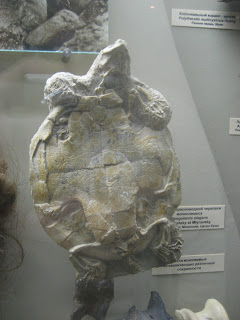The website of this museum has no English version, and Wikipedia doesn't say a whole lot, but UC Berkeley's Paleontology museum has on its website a description of what makes the Paleontology museum in Moscow so special.
The entrance to the museum has dinosaur images on the gates:
At the entrance to the exhibits is a large wall illustrating the development of life on earth, organized from bottom to top (with man on top). Look at the next two photos together, which have some overlap. These are enormous images, at least 3 stories tall when taken together.
At the start of the exhibits, to get people's attention, is one big dinosaur skeleton:
Other fossils nearby are smaller, such as a turtle:
Here's the underside of a horseshoe crab:
The next object was very exciting to see: a coelecanth!
These were believed to be extinct for millions of years until one was caught alive in the 1930s. I guessed this was a coelecanth before I read the information card. What other fish (with skin) could it have been?
The museum had many examples of impressions of very old plants or small animals left on rocks, or small petrified samples of turtle turd, but let's get back to the dinosaurs.
The next display must be showing what a skeleton looks like at the stage before it is put together in 3 dimensions.
And we end with some mammoths:
Here is a baby mammoth on its side (click on the photo for a better view; the head is under my right hand). I hope I don't get in trouble for touching the sign that says "Do not touch".
Finally, parts of this museum were brought to you by Chevron
which very much appreciates all multimillion-year-old dead plants and animals for decomposing and providing it with the fuel it needs to stay in business.
















Комментариев нет:
Отправить комментарий